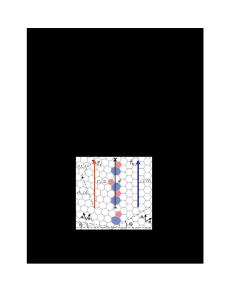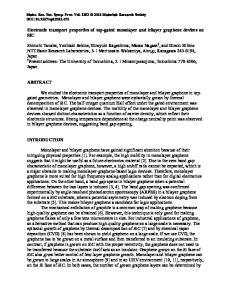The effect of line edge roughness defect on the electronic transport properties of Boron-doped graphene nanoribbon recti
- PDF / 3,350,862 Bytes
- 10 Pages / 595.276 x 790.866 pts Page_size
- 12 Downloads / 319 Views
The effect of line edge roughness defect on the electronic transport properties of Boron‑doped graphene nanoribbon rectifier Mozhgan Golzani1 · Mohammad Poliki1 · Saeed Haji‑Nasiri1 Received: 25 December 2019 / Accepted: 28 February 2020 © Springer-Verlag GmbH Germany, part of Springer Nature 2020
Abstract A rectifying behavior is achieved by means of boron doping in defected armchair graphene nanoribbon (AGNR). In the proposed AGNR device, the effect of line edge roughness (LER) is investigated on the electronic and transport characteristics. Moreover, the width of AGNR is changed by 6, 7 and 8 atoms in the fixed length, and the position of the boron doping is changed in the center or edge of the left electrode. The electronic features of the devices are analyzed through density function theory and non-equilibrium Green’s function method. The LER defect and any change in the doping position or the width of AGNR affect the energy alignments, molecular orbital levels, transfer functions and density of states (DOS) that lead to a change in the rectifying behavior of the device. Without the LER defect, rectifying ratio at the ribbon width of 7w in the presence of boron doping at the center, and edge is achieved 16 and 5.88, respectively. But interestingly, by considering the LER defect in the same situation these values increase to 362 and 102, respectively. Keywords AGNR · Boron doping · Rectifier · LER · Transport properties
1 Introduction Identifying the electronic transport properties and the special applications of nanostructures are among the main issues in the nanoelectronics, and many articles have recently been published in this field [1–8]. Graphene has a two-dimensional single-layer structure with a hexagonal network of carbon atoms [9–11]. Graphene and carbon nanotubes rank among the most commonly used carbonbased structures. These structures can be selected as an ideal choice for the future technologies due to their distinctive properties [12, 13]. In the recent investigations, graphene exhibits very interesting physical properties [14]. Charge carriers behave like massless relativistic particles and can only be described by the Dirac equation [9]. In addition, * Saeed Haji‑Nasiri [email protected] Mozhgan Golzani [email protected] Mohammad Poliki [email protected] 1
Faculty of Electrical, Biomedical and Mechatronics Engineering, Qazvin Branch, Islamic Azad University, Qazvin, Iran
graphene exhibits a high mobility at room temperature and in large amounts of impurities [15, 16]. Thermoelectric in nanoscale devices is also one of the challenging topics [17, 18]. Addition of impurities to graphene structures is one of the reasons, which alter thermoelectric properties [19–21]. Muley et al. reported that applying boron doping in graphene-base devices results enhancement in thermoelectric properties [22]. Graphene is a semiconductor with a zero band gap so to use this material as a semiconductor in electronic devices, a gap must be created using different method. The main method is
Data Loading...











